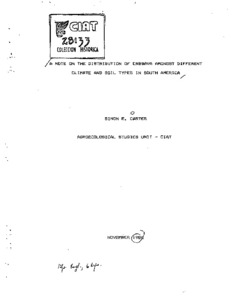A note on the distribution of cassava amongst different climate and soil types in South America
The distribution of cassava among different climate and soil types in South America, based on the adopted hierachical classification of soil and climate conditions for cassava, is briefly discussed. Both soil and climate components of the classification have been used to produce a map of environmental homologues for the crop. By subdividing cassava-growing areas on the basis of a simple climatic and edaphic classification, it is apparent that the ecosystems of CIAT`s cassava program cover some important climate-soil homologues; if the system is to be continuously used, a more systematic approach towards soils is required and there are some important semiarid and highland areas that are not currently covered. It is recognized that the cassava program cannot work specifically for all the different classes identified, but the knowledge of their existence and relative importance can help the process of deciding where to work and how many different ecosystems to work for. The organization of data in a microregion framework is seen as a longer-term solution to climatic and edaphic classification problems that arise in the cassava program`s research and planning. (CIAT)

